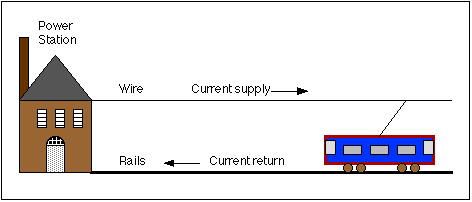
| Return to previous page |
|

Tram rails, in addition to performing all the functions of railway rails, also have to carry electrical currents returning from the tram to the power station (or sub-station).
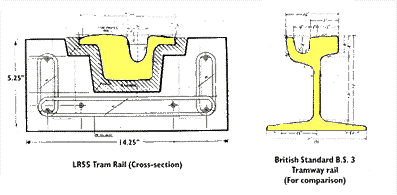
Tram rails were, and very often still are, designated by their
weight in Lbs per yard.The calculations for electrical resistance
are independent of shape and are only based on weight per yard.
The two rails shown in the illustration are very different in
section but have approximately the same weight of metal per yard
and hence the same electrical resistance. (For a larger version
of this drawing, click here)
The old British Standards for tram rails are reproduced below, but the properties of any modern rail section can be derived by comparing its sectional area with those in the table. (Note: The suffix 'c' denotes a special section for tight curves. The groove is a little wider than normal to allow the wheel flange to traverse the curve without binding; the lip is, of necessity, slightly thicker and longer, resulting in a heavier section)
|
Rail Section Number |
per Yard |
Sectional Area |
Section |
Flange |
|
||
|
|
Ohms / km | Ohms / mile | |||||
|
|
|
|
|
|
0.00002777 | 0.03038 | 0.04888 |
|
|
|
|
|
|
0.00002604 | 0.02848 | 0.04583 |
|
|
|
|
|
|
0.00002632 | 0.02878 | 0.04632 |
|
|
|
|
|
|
0.00002475 | 0.02708 | 0.04356 |
|
|
|
|
|
|
0.00002500 | 0.02734 | 0.04400 |
|
|
|
|
|
|
0.00002359 | 0.02579 | 0.04151 |
|
|
|
|
|
|
0.00002381 | 0.02603 | 0.04191 |
|
|
|
|
|
|
0.00002252 | 0.02563 | 0.03964 |
|
|
|
|
|
|
0.00002273 | 0.02486 | 0.04000 |
|
|
|
|
|
|
0.00002155 | 0.02357 | 0.03793 |
If we now look back to a previous
example which was used to find the voltage dropped along the
overhead wire.
We found that a tramcar drawing 200 Amps could create a voltage
drop of 50 volts in a kilometre of overhead wire.
The same tramcar would be returning 200 amps through the track, if this were B.S. 3 rail we could calculate the voltage difference along the track.
Rail resistance (B.S.3) = 0.02734 ohms per km, but the two rails are connected in parallel so the resistance is halved.
Voltage drop = Current x resistance = (0.02734 / 2) x 200 = 2.734 volts
This is far less than the voltage dropped in the overhead wire but could be significant in terms of electrolytic action caused by current being driven into the surrounding ground by this voltage. To avoid the dangers posed by this, a strict control must be kept on track resistance.
The resistance of track may also be increased by improperly made joints between track sections
Board of Trade Regulations
The Board of Trade used to regulate British tramways and the standards they applied are still useful guidelines to acceptable practice. They set a limit of 7 volts on the maximum voltage between the rails and true earth.
A chart has been prepared to allow simplified calculation of the voltage drop to be expected from certain track types according to vehicle power and track length.
For a full sized version of this chart, click here. (Caution - Large file 180 kb)
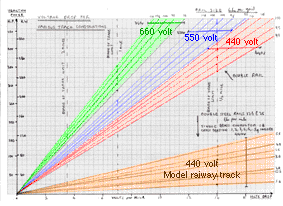 |
|
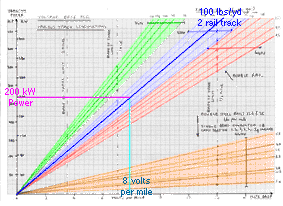 |
|
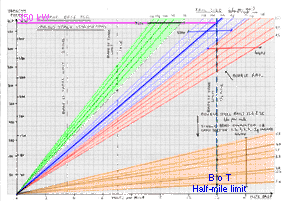 |
|
For a full sized version of this chart, click here. (Caution - Large file 180 kb)
Nowadays it is common to find track clad in
an insulating layer before being placed in the ground. This helps
to reduce leakage currents to a minimum and has the added advntage
of reducing noise.
Although the mastic materials used for encapsulatiuon are very
good insulators, the current can still leak from the unencapsualted
top surface of the rail, particularly in wet weather. Grassed track is slightly more vulnerable in this respect
if the grass is allowed to grow across the rail surface.
The insulation of track is not a panacea or a substitute for designing the system with as low a voltage drop as possible in the first place.
Tram poles and other metal tramway street furniture might become 'live' in the event of an insulation breakdown.
As an additional precaution, the metal bodies of these objects should be solidly connected to earth so that they cannot become live and, in the event of an insulation breakdown, excessive current would flow, operating a safety trip device and cutting off the power. Simply relying on the object being stood in the groud is insufficient, but the provision of individual earthing systems would be prohibitively expensive.
There was, in the past, no objection to bonding
street furniture to the tram rails which gave a good connection
for the return of fault currents. Nowadays, if objects are bonded
to insulated rails, the failure of a rail bond could result in
not only the track becoming live, but all the lamp posts, trolley
poles and tram stop furniture too - A highly dangerous situation.
There has even been a suggestion that trolley poles have become
sufficiently live, from the track voltage drop under normal running
conditions, for persons leaning on them to receive a shock in
wet weather. (This might be a useful way of discouraging dogs
from behaviour which rots the bases of the poles).
The provision of a separate earthing system, which also connects to a metal reinforcement mat under the rails, has been used as an effective but very expensive way of getting around this problem. It does have the advantage of permitting the detection of any earth fault currents separately from the traction supplies and cutting the power off automatically before harm can result.
| Return to previous page |
|
|